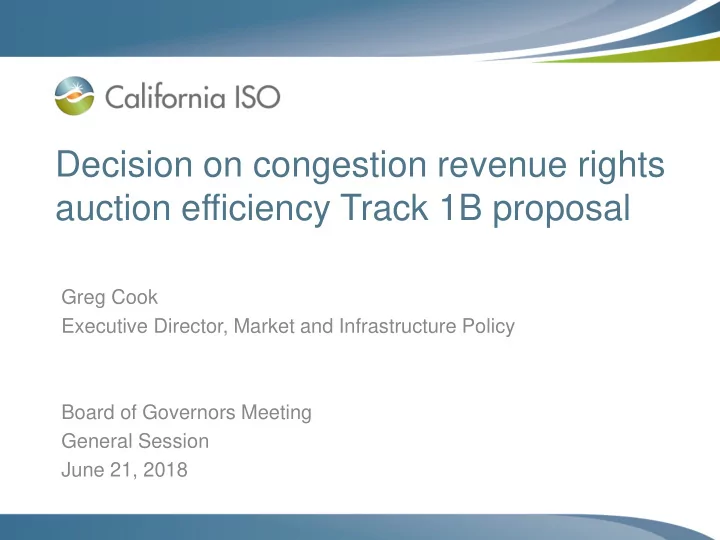

Decision on congestion revenue rights auction efficiency Track 1B proposal Greg Cook Executive Director, Market and Infrastructure Policy Board of Governors Meeting General Session June 21, 2018
Track 1A specifically targeted auction efficiency, Track 1B targets revenue inadequacy which has additional benefits to auction efficiency Revenue inadequacy Auction efficiency Page 2
Auction revenue shortfalls have a strong correlation to revenue inadequacy Page 3
Current congestion revenue rights market design results in inequitable allocation of revenue inadequacy • All revenue inadequacy is allocated to measured demand (load + exports) • No consideration of location of constraints causing revenue inadequacy • Provides incentives to procure low priced congestion revenue rights that profit purely from differences between auction model and day-ahead market model • Release thousands of megawatts of transmission capacity in the annual auction that is ultimately unavailable Page 4
Management proposes two enhancements to further address congestion revenue rights auction efficiency • Partial funding: Allocate revenue inadequacy to congestion revenue right holders in proportion to their flow over each constraint – Congestion revenue rights holders receive day-ahead market payments aligned with available transmission capacity – Results in equitable allocation to all congestion revenue rights holders on locational basis – Mitigates profits made purely on differences between auction model and day-ahead market model • Reduce the amount of system capacity released in the annual process from 75% to 65% – Resolves majority of annual auction infeasibilities Page 5
Example of partial funding proposal $10/MWh Congestion Charge all 24 Hrs. 800 MW CRR flow Reduced Limit 1000 MW Limit 500 MW Limit A B A B Under Current Design: CRR Payment = 800 MW * $10/MWh * 24 Hrs. = $192,000 Congestion Rent = 500 MW * $10/MWh * 24 Hrs. = $120,000 Revenue inadequacy charged to load = $192,000 - $120,000 = $72,000 Under Track 1B Proposal: Allocate revenue inadequacy to CRRs Ex: CRR 1 = 400 MW CRR 2 = 200 MW CRR 3 = 200 MW CRR 1 = $72,000 * 400 MW CRR 2 = $72,000 * 200 MW 800 MW = $36,000 800 MW = $18,000 CRR 3 = $72,000 * 200 MW 800 MW = $18,000 Page 6
Lower annual capacity release translates to lower monthly infeasibilities CRR infeasibilities in monthly auctions compared to percentages of capacity released in the annual process 9,000 Megawatts of annual CRRs Infeasible in each column 8,000 • Majority of annual 7,000 auction infeasibilities 6,000 ̴ 4,200 MW eliminated by difference 5,000 reducing system capacity released to 4,000 65% 3,000 2,000 1,000 0 75% 70% 65% 60% Percentage of system capacity released in annual process Season 4 Infeasibilities (MW) Page 7
Generally, other ISO/RTOs release less system capacity than the CAISO over equivalent timeframes * * *NYISO releases 100% from 4 to 6 months, 30% for 6 to 12 months, and 5% for 12 to 16 months *PJM releases 100% of what remains after adjustments for loop flows and historic flow ratings Page 8
Most stakeholders support the proposal to allocate revenue inadequacy to congestion revenue rights holders • DMM, SCE, Six Cities, and the CPUC support the proposal as an improvement – Continue to prefer a design in which only a “willing counterparty” would fund a congestion revenue right’s payments in exchange for a fixed payment • Other stakeholders oppose and offer different revenue inadequacy allocation methodologies • Some stakeholders recommend that the ISO first observes results of its track 0 and track 1A efforts Page 9
Stakeholders are divided on the proposal to reduce the amount of system capacity released in the annual process to 65% • MSC supports the proposal as a measure to protect congestion revenue rights holders from extreme de- valuations • CDWR is concerned that this proposal will impede their ability to obtain needed congestion revenue rights • PG&E is concerned that this proposal may prevent some congestion revenue rights that would have been revenue sufficient from being released Page 10
Management recommends the Board approve the congestion revenue rights auction efficiency track 1B proposal • Aligns congestion revenue right payments to available transmission capacity • Provides for equitable allocation of congestion payment shortfalls among all congestion revenue rights holders • Mitigates incentives to bid for congestion revenue rights that could have inflated payouts relative to auction prices • ISO will include analysis and data in its monthly market performance reports on the impacts of the proposal Page 11
Recommend
More recommend